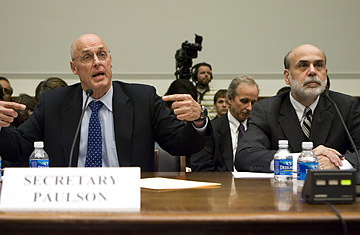
Treasury Secretary Henry Paulson, left, and Federal Reserve Chairman Ben Bernanke testify on Capitol Hill
Treasury Secretary Henry Paulson and his team are starting to look like short-order cooks stuck in a perpetual lunch-hour rush. The worse the economic crisis gets, the more confidence- and liquidity-boosting measures they cook up, from the Bear Stearns deal last spring to the AIG bailout last month.
Now the markets have devoured last week's passage of the titanic $700 billion bailout package without a trace. By the end of Tuesday, the Dow had dropped 1,400 points in five days, the biggest point loss ever. As increasingly gloomy job numbers pile on top of the continuing problems in the credit market, it seems the U.S. government may be running out of economic hash to sling.
But not yet. The indefatigable Paulson, along with Federal Reserve Chairman Ben Bernanke, this week unveiled a slew of new initiatives to try and restore confidence in the markets. On Tuesday, Bernanke unveiled a plan to try and gig the frozen market for commercial paper, offering to loan companies unlimited amounts of money three months at a time, sometimes with little or no collateral, a move unseen since the Great Depression. And at the Treasury, Paulson appointed a 35-year-old former Goldman Sachs banker as temporary head of the agency charged with using the $700 billion to lift bad loans out of the financial system. The banker, Neel Kashkari, immediately took bids from companies interested in running a market to price the bad loans. On Wednesday morning, in a surprising move, the Fed announced a half-point interest rate cut in unprecedented coordination with central banks in Asia and Europe.
To some critics, however, the efforts by Paulson and Bernanke look erratic and piecemeal, a constant dash from one fire to the next. And even Treasury officials are keeping a sober perspective about the effect their moves can have on a system as panicked as Americans' is. "This isn't going to be the new Treasury program that saves the world," says department spokeswoman Michele Davis. "That's not going to happen." But there is a unifying theme that explains much of what the big brains at the Fed and Treasury have been doing. And the efforts this week fit with the pattern.
After the 1929 collapse, which at its worst left a quarter of the workforce jobless, the U.S. instituted safeguards to ensure liquidity, confidence and trust in the U.S. financial system. There were four pillars: insuring the bank deposits of everyday Americans, allowing access to government funds in case of a panic, providing a regime for the orderly failure of badly run companies and limiting how much credit could be leveraged off a particular asset.
If the upside of that system was stability, though, the downside was a limit on how much money you could make with the capital you had. In the late 1970s, a lot of very smart Wall Street types managed to create a shadow banking system to finance more aggressive, risky and profitable investments, including novel vehicles based on the bad home loans peddled mostly (although not exclusively) by nonbank mortgage firms. (The government-sponsored Fannie Mae and Freddie Mac bought into the high-risk innovations of the shadow banking system around 2005 by buying a bunch of now-toxic mortgage-backed securities.)
The result was a parallel system almost as big as the banking system that had none of its post-Depression stabilizing pillars: no deposit insurance, no access to the lender of last resort, no resolution regime and only a patchworky, inadequate framework of restraints for risk-taking. In the old system, Americans' deposits in regular banks financed the system. In the shadow banking system, Americans' deposits in money market funds provided the asset anchor. As AIG teetered on the brink in mid-September, a run began by institutional investors on the money market funds.
The major initiatives unveiled by Paulson, Bernanke and New York Fed chairman Tim Geithner over the past months have all been efforts to do for the shadow banking system what was done for the regular banking system in the 1930s. To stop the institutional run on money markets, Paulson announced on Sept. 19 an insurance fund for them that would be backed up by funds usually reserved for currency stabilization. The AIG and Merrill Lynch interventions were attempts to dissolve failing companies in an orderly fashion without panic, as was the Wachovia bailout. The opening of the discount window to investment banks was the first effort to provide access to a lender of last resort. As for regulation, that will have to be something the Fed, Treasury, SEC and Congress tackle after the crisis crests.
This week's moves fit the pattern. But they also show just how far the crisis has spread. The decision to shore up commercial paper will allow companies that are unable to borrow money from either the shadow or the real banking system to have access to the lender of last resort (the government), ensuring that credit still moves in the system — hopefully. And the $700 million program Paulson is steaming ahead with will allow for the clearing of bad loans, and inevitably the orderly failure of companies that invested too heavily in them.
Will the moves work? Not even Paulson and Bernanke know. And what is most worrisome about the current crisis, and the latest moves it has necessitated, is that it shows how badly the shadow banking system has managed to undermine the traditional banking system by incentivizing those bad loans. Fueled by the shadow system's demand for loan-based derivatives, enough regular banks issued lousy loans that now they too are failing, hence the fate of Washington Mutual and Wachovia. In the worst case of an unchecked, full-blown panic, even banks that operated cautiously within the post-1929 safeguards could be vulnerable. At that point, Paulson and Bernanke would have to resort to even more extreme measures.
